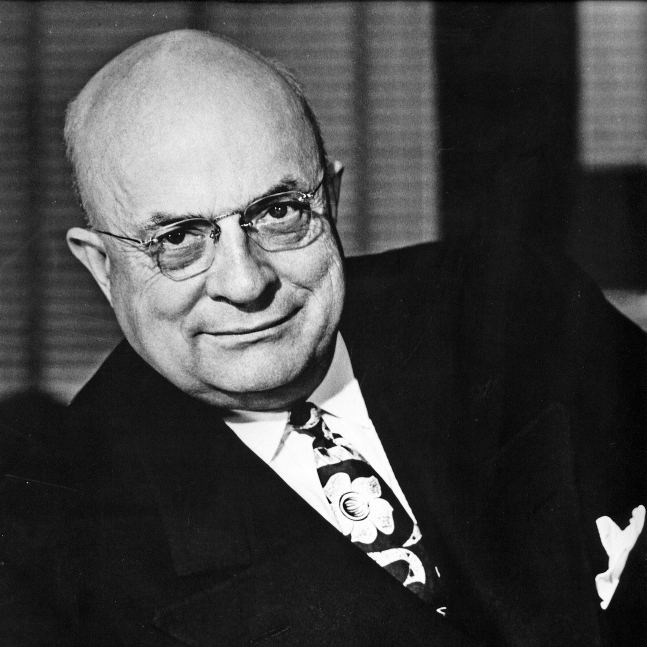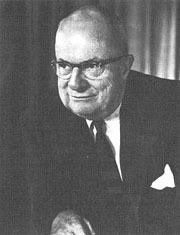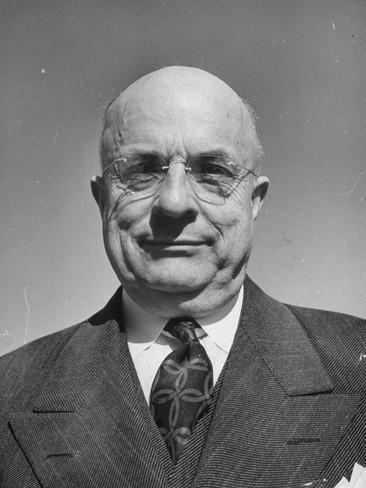Name Henry Kaiser | Role Industrialist | |
 | ||
Occupation Industrialist, shipbuilder Children Edgar Kaiser, Sr, Mary Carlisle Similar People Sidney Garfield, Edgar Kaiser - Jr, Mary Carlisle, Frank Crowe, James Blakeley | ||
Henry j kaiser 1882 1967
Henry John Kaiser (May 9, 1882 – August 24, 1967) was an American industrialist who became known as the father of modern American shipbuilding. He established the Kaiser Shipyards, which built Liberty ships during World War II, after which he formed Kaiser Aluminum and Kaiser Steel. Kaiser organized Kaiser Permanente health care for his workers and their families. He led Kaiser-Frazer followed by Kaiser Motors, automobile companies known for the safety of their designs. Kaiser was involved in large construction projects such as civic centers and dams, and invested in real estate. With his wealth, he established the Kaiser Family Foundation, a nonprofit, non-partisan, charitable organization.
Contents
- Henry j kaiser 1882 1967
- What s my line bennett hosts henry j kaiser julie london ernie kovacs panel sep 29 1957
- Early life
- World War II
- Kaiser Permanente
- Post World War II
- Death
- Legacy
- References

What s my line bennett hosts henry j kaiser julie london ernie kovacs panel sep 29 1957
Early life

Kaiser was born on May 9, 1882, in Sprout Brook, New York, the son of Franz and Anna Marie (née Yops) Kaiser, ethnic German immigrants. His father was a shoemaker. Kaiser's first job was as a cash boy in an Utica, New York, department store at the age of 16. He worked as an apprentice photographer early in life, and was running the studio in Lake Placid by the age of twenty. He used his savings to move to Washington state on the west coast of the United States in 1906, where he started a construction company that fulfilled government contracts.

Kaiser met his future wife, Bess Fosburgh, the daughter of a Virginia lumberman, when she came into his photographic shop in Lake Placid, New York to buy some film. Fosburgh's father demanded that Kaiser show that he was financially stable before he would consent to the marriage; Kaiser moved to Spokane and became a top salesman at a hardware company, returning ten months later with enough money to placate his future father-in-law. They married on April 8, 1907, and had two children, Edgar Kaiser, Sr and Henry Kaiser, Jr.

In 1914 Kaiser founded a paving company, Henry J. Kaiser Co., Ltd., one of the first to use heavy construction machinery. His firm expanded significantly in 1927 when it received an $18-million contract to build roads in Camagüey Province, Cuba. In 1931 his firm was one of the prime contractors in building the Hoover Dam on the Colorado River, and subsequently the Bonneville and Grand Coulee Dams on the Columbia River.
While doing business among the "Six Companies, Inc." , and remotely related to his interest in motor boat racing, he set up shipyards in Seattle and Tacoma, where he began using mass-production techniques, such as using welding instead of rivets.
World War II
Henry Kaiser was an early advocate of bringing American aid to those suffering from Nazi aggression in Europe. In 1940, a full year before the then-neutral US had entered World War II, Kaiser was serving as National Chairman of United Clothing Collection for International War Relief to provide much-needed clothing for the refugees from Hitler's conquests in Europe, while the U.S. was still 'isolationist'. Many leading industrialists, such as Henry Ford, were pro-Fascist and adamantly against the US entering the conflict until December 7, 1941.
Kaiser fought Hitler far more directly with what he is most famous for: the Kaiser Shipyard in Richmond, California; during World War II adapting production techniques to enable building cargo ships with an average construction time of 45 days. These ships became known as Liberty ships and were later supplemented in the mid-war period by improved, larger and faster Victory ships. He became world-renowned when his teams built a ship in four days.
The keel for the 10,500-ton SS Robert E. Peary was laid on Sunday, November 8, 1942, and the ship was launched in California from the Richmond Shipyard #2 on Thursday, November 12, four days and 15½ hours later. The previous record had been ten days for the Liberty ship Joseph M. Teal.
A visit to a Ford assembly plant by one of his associates led to the decision to use welding instead of riveting for shipbuilding. Welding was advantageous because it took less strength to do and it was easier to teach to the thousands of employees, mostly unskilled laborers and many of them women. Kaiser adopted the use of sub-assemblies in ship construction; formerly, hundreds of laborers crowded together to complete a ship. Though this practice had been tried on the East Coast and in Britain, Kaiser was able to take full advantage of the process by constructing new shipyards with this in mind.
Other Kaiser Shipyards were located in Ryan Point (Vancouver) on the Columbia River in Washington state and on Swan Island in Portland, Oregon. A smaller vessel was turned out in 71 hours and 40 minutes from the Vancouver yard on November 16, 1942. The Kaiser hulls also became America's smaller, more numerous "escort carriers", over one hundred small aircraft carriers employed in both the Pacific and the Atlantic theaters. The concepts he developed for the mass production of commercial and naval ships remain in use today.
One problem with welded hulls, unknown at that time, was the issue of brittle fracture. This caused the loss of some Liberty ships in cold seas as the welds failed and the hulls would crack—sometimes completely in two. Constance Tipper was one of the first people to discover why the Liberty ships were breaking in two. Minor changes in design and more rigid welding control implemented in 1947 eliminated Liberty ship losses until 1955. Through his membership in a group called the Six Companies, Kaiser also had a major role in the Joshua Hendy Iron Works of Sunnyvale, California, which built the EC-2 triple expansion steam engines for the Liberty ships. Kaiser and his associates organized the California Shipbuilding Corporation.
Kaiser Permanente
At Kaiser Shipyards in Richmond, California, Kaiser implemented the pioneering idea of Dr. Sidney Garfield of Kaiser Permanente. Opened on August 10, 1942, Kaiser Richmond Field Hospital for Kaiser Shipyards was financed by the U.S. Maritime Commission, sponsored by Henry J. Kaiser's Permanente Foundation, and run by Dr. Garfield. In part due to wartime materials rationing, the Field Hospital was a single-story wood frame structure designed in a simple modernist mode. Originally intended for use primarily as an emergency facility, the Field Hospital opened with only 10 beds. Later additions increased its capacity to 160 beds by 1944.
Kaiser's Richmond Field Hospital served as the mid-level component of a three-tier medical care system that included six well-equipped First Aid Stations at the shipyards, and the main Permanente Hospital in Oakland, where the most critical cases were treated. By August 1944, 92.2 percent of all Richmond shipyard employees had joined Kaiser Permanente, the first voluntary group plan in the country to feature group medical practice, prepayment, and substantial medical facilities on such a large scale. After the war ended, the Health Plan was expanded to include workers' families. To serve employees at his diverse businesses, Kaiser opened Permanente facilities in Walnut Creek, California, in Hawaii, in Southern California, and eventually in many other locations. Since then, locations have opened in Dublin, California, Livermore, California, Pleasanton, California, Martinez, California, Santa Clara, California, and Antioch, California.
Post-World War II
As a real-estate magnate, Kaiser founded the Honolulu suburban community of Hawaiʻi Kai in Hawaiʻi. Kaiser also financed the development of Panorama City, a planned community in the San Fernando Valley portion of Los Angeles. Schools were named in his honor in Hawaii, West Virginia, and California.
In 1945, Kaiser partnered with veteran automobile executive Joseph Frazer to establish a new automobile company from the remnants of Graham-Paige, of which Frazer had been president. It would use a surplus Ford Motor Company defense plant at Willow Run, Michigan originally built for World War II aircraft production by Ford. Kaiser Motors produced cars under the Kaiser and Frazer names until 1955, when it abandoned the U.S. market and moved production to Argentina. In the late 1960s, these South American operations were sold to a Ford-Renault combination. In 1953, Kaiser purchased Willys-Overland, manufacturer of the Jeep line of utility vehicles, changing its name to Willys Motors. In 1963, the name was changed again to Kaiser-Jeep, which was ultimately sold to American Motors Corporation in 1970. As part of the transaction, Kaiser acquired a 22% interest in AMC, which was later divested.
Kaiser founded Kaiser Aluminum in 1946 by leasing and later purchasing aluminum facilities in Washington state from the United States government. The original facilities included reduction plants at Mead and Tacoma, and a rolling mill at Trentwood. Kaiser Aluminum expanded to become a broad-based member of the aluminum industry, involved in the mining and refining of bauxite and creation of alumina, the production of primary aluminum from alumina, and manufacturing of fabricated and semi-fabricated aluminum products.
In 1948, Kaiser established the Henry J. Kaiser Family Foundation (also known as Kaiser Family Foundation), a U.S.-based, nonprofit, private operating foundation focusing on health care issues. Originally based in Oakland, California, it later moved to Menlo Park, California. At Kaiser's death, half of his fortune was left to the foundation. It was reorganized and restructured in 1991, under CEO Drew Altman. The Foundation, not associated with Kaiser Permanente or Kaiser Industries, operates independently as a think tank, making facts and analysis available to policymakers, health care groups, the media and the general public.
Kaiser Permanente Federal Credit Union (Kaiperm FCU), founded in 1952, and Kaiser Federal Bank, founded in 1953, were credit unions for employees of the various Kaiser hospitals and medical groups. As of 1999, Kaiser Permanente Federal Credit Union became a federal thrift charter. In September 2008, The National Credit Union Administration (NCUA) selected Alliant Credit Union in Chicago to acquire the assets of Kaiperm FCU of Oakland, California. The purchase and assumption was completed on September 26, 2008. Kaiser Federal Bank was converted to a federal mutual savings bank in 1999. It was renamed Simplicity in 2012 and later sold to HomeStreet Bank. Kaiser Federal Financial Group, Inc., is a Maryland corporation that owns all of the outstanding common stock of Kaiser Federal Bank.
In the mid-1950s, Kaiser asked William Besler to convert his 1953 Kaiser Manhattan to steam. Besler completed this in either 1957 or 1958. Kaiser did not like the remodeled car and left it with Besler.
Kaiser's first wife Bess Fosburgh died on March 14, 1951, after a prolonged illness. Kaiser married the nurse who had cared for her, Alyce Chester (reportedly with his wife's blessing) on April 10, 1951. He adopted her son, who as Michael Kaiser attended nearby Lafayette public Vallecito School. But Kaiser's attention soon transferred to Hawaii, and in 1955 he moved his family there. (After Kaiser moved to Hawaii the west Lafayette Kaiser estate deteriorated and was eventually demolished; today the property is unrecognizable, subdivided into several homes.)
Kaiser spent much of his later years in Honolulu and developed an obsession with perfecting its urban landscape. He built the Kaiser Hawaiian Village Hotel, today known as the Hilton Hawaiian Village, and used bright pink Jeeps as resort transportation. Kaiser constructed one of the first commercially practical geodesic domes in the United States at this resort and used it as a theater.
In the mid-1950s Kaiser was convinced that television could make Kaiser brand products known to the public. He partnered with Warner Brothers and ABC to sponsor the television series Maverick, promoting household products including Kaiser aluminum foil and Kaiser cars. In support of his Hawaii ventures, Kaiser induced Warner Brothers to copy the formula of its popular series 77 Sunset Strip as new TV series Hawaiian Eye. Though actually filmed at WB studios in Burbank, California, the show featured private detectives based at Kaiser's Hilton Hawaiian Village. Kaiser eventually bought and built a chain of radio and television stations which became known as Kaiser Broadcasting. Some call signs included his initials "HK", beginning in 1957 in Honolulu with KHVH-TV 13 and KHVH AM 1040.
Death
On August 24, 1967, Kaiser died at the age of 85 in Honolulu. He is buried in Mountain View Cemetery on "Millionaire's Row", in Oakland, California.
He was survived by his second wife, Alyce Chester Kaiser, who inherited half his fortune, and by his elder son, Edgar F. Kaiser, who had been president of the Kaiser Industries Corporation since 1956.
One of Kaiser's grandsons, Edgar Kaiser, Jr, became president of Kaiser Steel from 1981 to 1984, and briefly owned the Denver Broncos NFL franchise. Another grandson, Henry, is an Antarctic diver and experimental guitarist.
Legacy
Kaiser was involved in building civic centers, roads, and schools. He was part of the consortium that constructed the Hoover Dam and Grand Coulee Dam. Kaiser is also noted for advancing medicine with the development and construction of hospitals, medical centers and medical schools. The mining town of Eagle Mountain, California, built as part of the West Coast's first integrated mining/processing operation, and linked by rail to his mill in Fontana, California, was the birthplace of Kaiser Permanente, the first health maintenance organization.
A class of 18 United States Navy fleet replenishment oilers built in the 1980s and 1990s is named the Henry J. Kaiser class. Its lead unit, USNS Henry J. Kaiser, the first U.S. Navy ship named for Kaiser, entered service with the Military Sealift Command on December 19, 1986.
In 1990, Kaiser was made a member of the Labor Hall of Fame of the U.S. Department of Labor in Washington, D.C., supported by the Friends of the Department of Labor.
On December 1, 2009, Governor Arnold Schwarzenegger and First Lady Maria Shriver inducted Kaiser posthumously into the California Hall of Fame in The California Museum, Sacramento, California.
